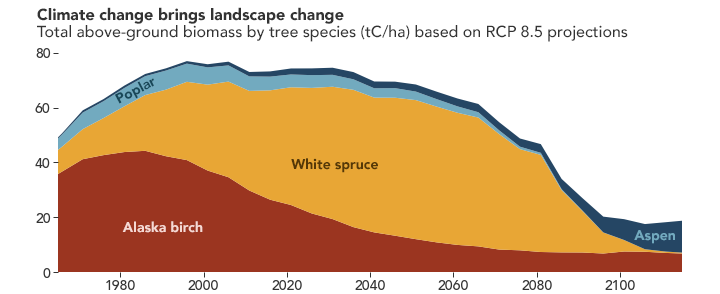

In a future with higher temperatures and other climate changes, Alaska’s boreal forests could look significantly different than they do now. According to a new study that is part of NASA’s Arctic Boreal Vulnerability Experiment (ABoVE), the warmer, drier conditions of the future could lead to a net loss of plant life in some regions of Alaska, while also changing the ratio of species that grow in them. These vegetation changes caused by global climate change could, in turn, affect Arctic climate in complex ways.
Boreal forests of high northern latitudes contain conifers, such as the black and white spruce that dominate Alaskan forests, and deciduous trees, like aspen and birch. In a warmer future, the ratio of conifers to deciduous trees is likely to change, with aspen and birch trees increasing compared to black and white spruce.
A research team led by Adrianna Foster of Northern Arizona University adapted and ran a computer model capable of making detailed simulations down to the level of individual trees. The scientists depicted the future landscape in a portion of eastern Alaska under two climate change scenarios: one in which greenhouse gas emissions are moderately reduced, and one in which they continue to increase at current rates.
In both scenarios, the total biomass—the amount of plants and trees—decreased across the study area, though there were some different nuances by area. Cooler, wetter areas saw increases in biomass, as did areas at higher elevations. Areas that are already dry today saw biomass loss in the future, as trees competed for increasingly scarce moisture and nutrients. In some areas, more drought-tolerant species thrived up to a point, then died as soils became too dry.
The map above shows the projected gain or loss of biomass across a study area in central Alaska; it is based on the climate scenario where greenhouse gas emissions continue to increase at present rates. Across the center of the region, drier areas lose trees and plants, while cooler, wetter areas and higher elevations see gains.
In the plot below, overall biomass decreases between 2000 and 2100 under the climate scenario with no greenhouse gas reduction, and the proportions of species also changes. The proportion of birches decreases steadily, while white spruce dominates the landscape until the end of the century.

“Deciduous trees can tolerate drought a little better than spruce trees can. They also grow faster,” said Foster, the study’s lead author. “So with fires increasing and the climate getting drier, the landscape becomes better suited to the deciduous species that can move in and outcompete the spruce, which is slower-growing and stressed by drought.”
Boreal forest fires are expected to become more frequent and severe in a warmer, drier climate, and these fires also will play an important role in the proportion of which tree species grow. “Deciduous species can more easily regenerate on exposed soil,” Foster explained. “So when we have these combinations of more drying, more severe fires, and more exposed soil, the deciduous species will be able to colonize very quickly. Under past conditions, they would then be replaced by conifers. But under climate change, the conifers may die off, leaving a deciduous forest.”
Changing the number of deciduous forests in Alaska’s boreal region could have complex effects on the climate. Deciduous trees lose their leaves for part of the year, allowing more sunlight to reflect off the land surface during colder, snowier periods. This can help lower air temperatures. Thawing permafrost and increased precipitation in some areas will release more water into the soil, allowing increased growth in some cooler areas, especially of black spruce.
But that melting permafrost will also release carbon into the atmosphere, acting as a positive feedback that contributes to warming. The loss of trees to fire or stress will mean biomass is lost and more carbon is put back into or left in the atmosphere. “Most of the carbon that is locked up in the boreal zone is in the soils,” she said. “So when we have the shift from boggy, black spruce forest to drier, deciduous forest, we are releasing a lot of carbon into the atmosphere from the soils.”
As the species and climate change, these processes could feed back into the climate in complex ways. “It’s not a linear relationship,” Foster noted. “We have all these interacting factors, and some are counteracting each other. It’s really an uncertain future.”
NASA Earth Observatory images by Joshua Stevens, using data courtesy of Foster, A.C., et al. (2019), and data from NASA/METI/AIST/Japan Space Systems, and U.S./Japan ASTER Science Team. Story by Jessica Merzdorf, NASA Goddard Space Flight Center.